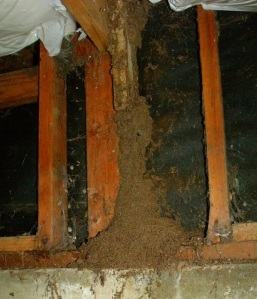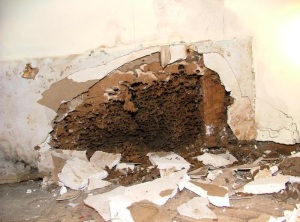One of the most common wood destroying organisms in the NW is the Moisture Ant.
Like Dampwood Termites and Anobiid Beetles, they are “opportunistic” in the sense that moisture conditions have to be correct (conducive) for them to be present.As a Licensed, Washington State, Home Inspector and a Licensed Structural Pest Inspector, if I found evidence of these critters in your home–either past or present–the following is what you would see in your Inspection Report:
Moisture Ant colonies typically start in already decayed wood and are considered a secondary infestation. Their nests are designed to promote moisture and further decay of the wood they cover. Removal of the damaged wood and replacement with sound wood will be required in some cases. Moisture ants require moisture to thrive, and eliminating the moisture source must be part of control measures.
Added to this statement would be their location and a description of the damage and the possible causes of the leaking. It might not be possible to determine the extent of damage, because the actual damage might be located much further away from where their visual signs are found.
For example, in this case, the Moisture Ant structure extending from the top of the foundation up to the floor structure.

While there was minor decay present in the wood covered by this structure, the bulk of any damage is likely above the floor structure somewhere else. In this case, the area of real damage is somewhere in the chase around the insert fireplace. It will likely be necessary to remove some of the siding to actually figure out how much damage there is and to determine the source of moisture that is, or was, supporting the colony. In this case, there was no present activity–the nest was only damp. There is not enough moisture being introduced for the structure to stay wet enough to support the colony. Given some elevated moisture, this indicates an infestation that is likely seasonal–when long periods of rain allow enough moisture into the area to support their presence.It is not unusual to see
Moisture Ants come and go in the home as the moisture conditions come and go.Of all the insects we deal with as Structural Pest Inspectors, I think I am most fascinated with
Moisture Ants. Partly because I know that they are not the “real” problem and the extent of damage is usually not going to ruin the house–like
Anobiid Beetles can.You can think of
Moisture Ants as sort of a “flag” waving at you. The flag is saying, “HEY, knucklehead, you have a leak over here!” When the leak is fixed, the ants go away. You don’t have to get out your arsenal of non-environmentally safe chemicals and, ATTACK! They are smart and know when they are not wanted–and simply leave.They build these marvelous structures called “carton” out of the materials they eat. Take a look at this picture of
Moisture Ants carton behind a baseboard electric heater.They have taken the wet cellulose fiber and turned it into some of the coolest carton I have found.

This wet “nest” now acts like a sponge and keeps surrounding wood structures wet. This extends the moisture into structures that were previously not wet. As this wood decays it too becomes food and habitat for the Moisture Ants–and the colony can grow. It is this ability to expand their nests into previously dry areas and causing decay/rot that gets them classified as a “wood destroying” insect.
In reality, whoever didn’t notice the leak, and fix the leak might also be considered a wood destroying organism. It is generally human beings that create the conditions that are conducive to many wood destroying insects in our homes.
Blog written by Charles Buell, Real Estate Inspections in Seattle (Licensed Home Inspector #220 & Licensed Structural Pest Inspector #67488).
Kerstin G. Brooks
Brooks & Heinze Real Estate Team
Seattle, WA
47.699083
-122.326868

